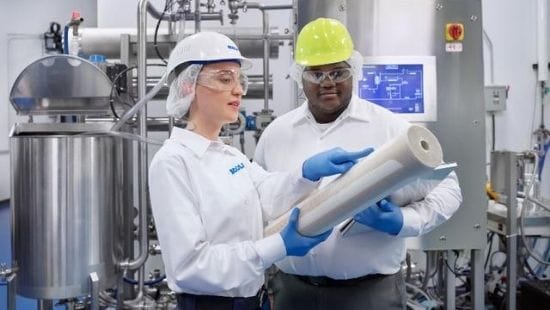Sanitary design combined with the right chemicals is the best way to meet your goals for cleaning, sanitation and operational efficiency

You have a robust cleaning and sanitation program that includes documented procedures, employee training, regular monitoring and verification, and best-in-class chemistry and clean-in-place technologies. Yet you are struggling to meet your production efficiency targets due to a slow and sometimes labor-intensive sanitation regimen.
The problem may lie in the design of your facility or processing equipment.
Sanitary or hygienic design refers to the application of design techniques that allow for efficient and effective cleaning of manufacturing equipment and related infrastructure in food and beverage processing facilities. Not only does sanitary design minimize the risk of product contamination, protecting your consumers, brand and reputation, it helps to drive operational efficiencies, potentially helping you to improve sanitation turnaround time and pre-operational swab results.
Making a point
Consider this example. During a sanitary design workshop, I hand attendees a wipe and a bolt dipped in chocolate. I challenge participants to clean the bolt as fast as possible, with no chocolate or haze remaining.
As the group cleans, I describe why the exercise is so difficult. Chocolate is surprisingly hard to remove. With sharp edges, threads that come to a point, and no internal radius, the design of the object also makes it tough to clean. In fact, even after cleaning vigorously for 10-15 minutes, no one is close to meeting my cleanliness standards.
My point? If you are spending too much time, energy or resources on cleaning and you still are not meeting your standards for cleanliness and sanitation, it is time to think about sanitary design.
A complete program
Thorough cleaning and sanitizing in a food and beverage facility is as critical as the products produced. As you can see from the example above, that task becomes much more difficult and ineffective when consideration is not given to equipment or facility design.
A complete sanitary design program should include the involvement of a cross-functional team, standards and principles, a review process, controls to manage gaps, and a plan to make modifications and repairs as needed. While I can’t cover all that here, understanding some key sanitary design principles will help you begin to identify where bacteria might be taking up residence in your facility, causing contamination concerns.
Standards vs. principles
You can think about sanitary design in terms of principles or standards, but they are not interchangeable. Principles are general underlying guidelines for designing something. Anyone can apply the principles whether or not their specific industry or piece of equipment has design standards. Principles offer a good starting point early on your journey toward sanitary design.
Standards are much more exact and typically involve specific engineering specifications when building or constructing equipment or facilities. They may include details such as what materials and finish to use.
Where to begin
While principles can vary by industry or facility (many of the best companies will create their own modified or improved versions) these six are often core to effective sanitary design programs.
- Cleanable to a microbiological level. Equipment must be constructed and maintained to ensure effective and efficient cleaning over its lifespan. It should be designed to prevent the ingress, survival and multiplication or microorganisms and the removal of allergens on both product and non-product contact surfaces. Note that the definition of “clean” might vary depending on the industry.
- Accessible for sanitation. You (or a mechanical device) should be able to get into all areas to perform proper inspection, maintenance, cleaning and sanitation. You should be able to see all areas and be able to disassemble equipment with tools for cleaning and inspections.
- No harborage or niche areas. A niche is a location that supports microbial growth and is protected from the sanitation process. It is characterized by high microbial counts after normal cleaning and sanitation. Niches often include cracks, corrosion, recesses, open seams, protruding ledges, inside threads, bolts, rivets, dead ends and tack welds. Harborages are growth niches that contain soil material.
You should eliminate harborage or niche areas, which cannot effectively be cleaned and sanitized in a reasonable amount time with normal tools and supplies. They are hot spots for microbial and allergen hazards.
- No collection points. Make sure your plant stays as dry as possible. All surfaces should be designed to be self-draining and to prevent pooling. Horizontal members on equipment should be rounded or angled to prevent buildup of liquid or product. Surfaces should be made of material that will not warp over time and create collection points, moisture should not drip, drain or draw into product areas, and conveyor belts should be tense enough to prevent collection or pooling. Dead spaces where product or liquid can collect should be eliminated.
- No or minimal hollow areas. Hollow areas allow for the collection of nutrients and water, and they are difficult to clean or not cleanable at all. We recommend that all hollow areas be hermetically sealed so nothing can get in or out. If not, eliminate the hollow area. For instance, instead of square tubing, use angle iron. You can find hollow areas in equipment and the environment.
- Validated sanitation procedures. First, collect scientific evidence using published sources or studies that show whatever you are going to do is possible and can be successful in your plant. Next, collect the data in your plant to show the solution you have come up with is working as you intended. This might include microbiological swabs of indicator organisms, swabs of allergens or proteins, or visual observations.
Ecolab can support you through the validation process by helping you to confirm you are using the right chemistry for the equipment, soils and surfaces in your facility.
A holistic program
Food and beverage facilities have their cleaning and sanitation challenges, but a good sanitary design program combined with the right chemical and system solutions can help to ensure your equipment and facility are visually, chemically and microbiologically clean. While not all-inclusive, the six principles discussed provide a good starting point regardless of your industry.



